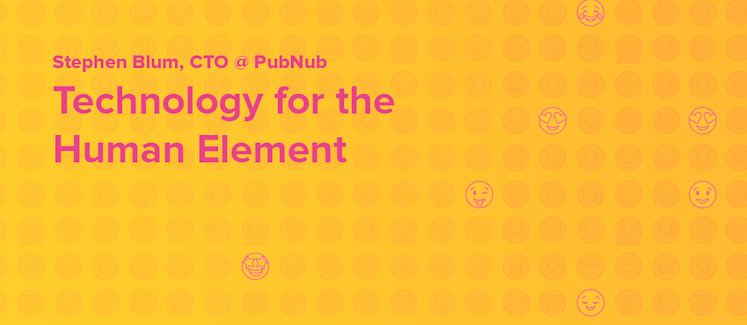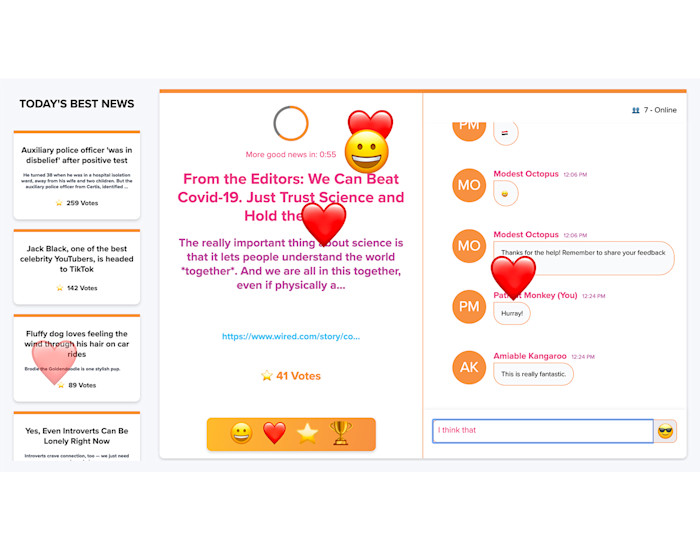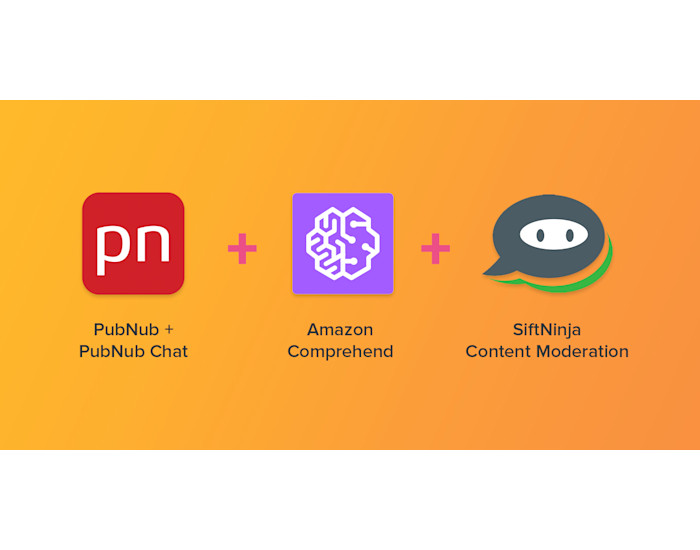
The Good News Machine
Right now, we’re all remote. This means that our social lives, daily interactions, and close relationships all have moved to a digital world. Of course, the core of social relationships is sharing experiences together, reacting to events, and the resulting interchange of emotions. Emoji, gifs, and message reactions are all proof.

In addition to our company-wide response to COVID-19, we decided to use our technology to build the Good News Machine. In a nutshell, this app runs sentiment analysis on headlines from across the world, and shares a good one every 90 seconds. Every user engaged with the app will see the same headline, and can react to it via emoji reactions, or in live chat. It’s a small, simple way to see something positive in a sea of ill tidings.
Enabling Human Interaction
The Good News Machine serves up good news, but it is also a place where the same news is shared between all users, possibly thousands, at once. In addition to making the remote world a brighter one, the app lets you know how others are reacting to the news in real-time. In other words, sharing is built-in.
Why focus on sharing?
When you make a live experience interactive, even in a simple way, it becomes a spark for social encounters. It enables people to make contact, and to affect one another in a small way. So, while the good news is important to see, it’s really a vehicle for something else.
When you make a live experience interactive, even in a simple way, it becomes a spark for social encounters.
What is really on offer here, what’s truly valuable, are the reactions and feelings that are shared between us. In effect, this shows us that remote interaction is still human interaction. And, sharing positive experiences amplifies their effects. What we consider good is amplified by the positive feelings of others.
By offering the headline, reactions, and chat to all, together, the Good News Machine facilitates a true social gathering, virtually.
Edge Messaging for Sentiment Analysis and Moderation
This is all achieved by sharing reactions using an edge messaging infrastructure. The infrastructure behind the app ingests a feed of articles, running sentiment analysis on the edge to decide whether or not a headline is truly good news, before pushing it to all users.
Plus, all users are kept in sync, viewing the same headline, regardless of number or location. It’s the same technology that powers trillions of other unique, remote interactions around the world every day.

As people react to the news, their reactions are shared with everyone. Finally, this same infrastructure hosts the live chat functionality that lets users engage directly with one another. As with the basic sentiment analysis, edge computing is also used to access Sift Ninja, filtering profanity out of chat messages so that chat stays positive, too.
Building Good News
Traditionally, to set up this style of technology, you would look to open source solutions to:
Serve the same article to all users in real time
Aggregate reactions
Display reactions to all users when they happen.
You’d need to select a sentiment analysis solution, and you'd ensure that sure your infrastructure can process all the required headlines.
Then, you’d create a deployment architecture, review expected scale requirements, bring together the team and specify goals to begin the development of your aggregation system. But, all of this is only the beginning.
The infrastructure required to transmit and aggregate our reactions is the first phase. Next, you need to build a user interface that allows the display of the results, sharing those user reactions in real time.
When you're building a digital interaction that's intended to feel immediate and organic, you need a responsive experience.
Beyond this, if you want to implement live, responsive chat, you’re looking at creating what amounts to the backend of an entire application. These things are mission-critical to applications that provide exciting and powerful remote interactions, but are prohibitive to scope and build from scratch.
When you're building a digital interaction that's intended to feel immediate and organic, you need a responsive experience. That means a nice interface, but it also means that messages go through in a flash. It means everybody really is synchronized, and it means everybody can see and react to your activity as it happens.
Key Takeaways
Rather than taking on all this scope, you’d be off to a good start by looking into real-time platforms that offer edge-computing, built-in integrations with sentiment analysis providers, and a chat API. Bringing these elements together, we were able to build this app quickly.
In all, the value we found in the Good News Machine is that it brings the shared, missing human interactions we expect to the digital world. In other words, the good news isn't just good news— it’s a way to finally reconnect with others. For this, we need to see how others react. With PubNub power, the human element comes through.